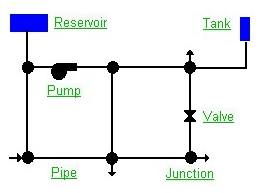EPANET - Network Components
EPANET models a water distribution system as a collection of links connected to nodes.
The links represent pipes, pumps and control valves.
The nodes represent junctions, tanks and reservoirs.
The figure below illustrates how these objects can be connected together to form a network:

In the picture, click:
 Reservoir - nodes that represent an external infinite source or sink of water to the network
Reservoir - nodes that represent an external infinite source or sink of water to the network Tank - are nodes with storage capacity, where the volume of water stored can vary over time during a simulation
Tank - are nodes with storage capacity, where the volume of water stored can vary over time during a simulation Junctions - are points in the network where links come together and where water enters or leaves the network
Junctions - are points in the network where links come together and where water enters or leaves the network Pipes - The pipes lead the water from one point to another in the network. EPANET assumes that all pipes are full at all times
Pipes - The pipes lead the water from one point to another in the network. EPANET assumes that all pipes are full at all times Pumps - Pumps are devices that transmit energy to a fluid, thus increasing its hydraulic load
Pumps - Pumps are devices that transmit energy to a fluid, thus increasing its hydraulic load Valves - Valves are used to control pressure or flow at a specific point in the network
Valves - Valves are used to control pressure or flow at a specific point in the network
In addition to these physical components, an EPANET project can contain the following objects that describe the performance and operation of a distribution system:
 Curves - are objects containing pairs of data that represent a relationship between two variables
Curves - are objects containing pairs of data that represent a relationship between two variables Time Patterns - collection of multipliers that can be applied to a quantity to allow it to vary over time
Time Patterns - collection of multipliers that can be applied to a quantity to allow it to vary over time Controls - instructions that determine how the network is operated over time
Controls - instructions that determine how the network is operated over time Analysis Options
Analysis Options

